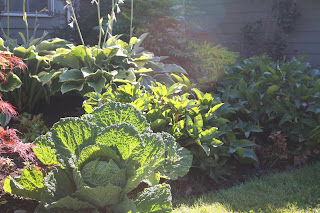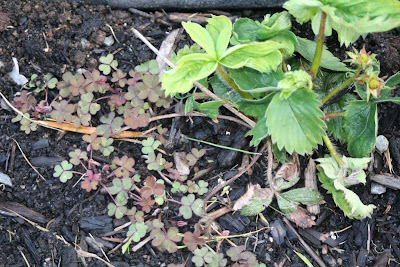I took a class last weekend on pest management in the garden through Seattle Tilth. Walked away with a better appreciation of Integrated Pest Management -- and a curiousity about my weeds and flowers.
In IPM, prevention is the first strategy. And a gardener must realize that there is no such thing as perfect. A few holes or bad bugs doesn't mean failure -- it means you are part of something alive. A gardener using IPM must be patient. Live with the 'bad things' and make sure they are bad before acting. This keeps you from applying a solution that is worse than the problem.
I found these leaves in my raised bed -- but I don't know what is causing the problem, so my strategy is to OBSERVE until I do. See, I am not too late. I need time to understand (or to learn so I can understand.) If the damage spreads quickly to other leaves, then I will act fast. If not, I am free to dawdle.
In the meantime, I can pick on the things I do understand. Practicing IPM means spending more time looking at your garden closely. The big things are obvious when they arrive.
But the little things are there too. This catapillar I found on on a piece of bark that made it into the raised bed. Its color was so unusual (to me) that I took a picture of it before I squashed it (too close to my cabbage.)
By looking closely I also found this guy. Turns out it is a stink- or a shield-bug (it took a lot of internet research to figure that out.) How did I make it out of childhood and not know that?! I wasn't sure what to do about it since I kept seeing online that it likes to eat hawthorn leaves until I found
this page that said it was happy eating any broadleaf plant. Since I found it on the trellising above my struggling (hole-y) bean plants, I got rid of him.
The first 'aggressive' IPM strategy is physical control -- which includes making barriers and handpicking offenders. I found the four slugs below under the wrapper leaves of my cabbage. Clearly garden pests, they did not survive the shoe test.
I was really worried that all the holes in my cabbage leaves would mean the heads would be teaming with worms -- but they were beautiful once I opened them up. I am wondering if all the damage was done by slugs and not the offspring of the white moth I saw in the yard. But the slugs don't explain all the tiny poop I saw. The next step in IPM strategy is to introduce natural predators to your garden -- maybe I got lucky and some good bugs took care of the (possible) cabbage maggots for me.
The last strategy for eliminating pests using IPM is employing a chemical control. The tip is to always start with the mildest remedy -- such as soap spray. And then make sure your soap spray is made out of a mild soap like Doc Bronners if you want to keep you veggies as healthy as can be.
Finally, I figured out that I am going to have to learn a lot more about bugs and plants before I really understand what is going on in my yard. There is a lot to know about bugs (good and bad) and their lifecycles. There is a lot to know about plants -- what I want to eat, what good bugs need to thrive, and what a weed's location might say about soil.

















































